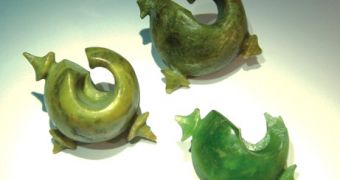Jade has been valued in Asia even from ancient times and now it comes with a new story: jade jewelry coming from ancient burial sites across Southeast Asia reveal one of the largest ancient marine trading routes, as revealed by a new research published in the Proceedings of the National Academy of Sciences.
Geological analysis revealed that the majority of 144 sampled artifacts, some 5000 years old, were coming from Taiwan, the island located 190 mi (120 km) off the coast of mainland China. The Taiwanese semiprecious stone went through trade into Southeast Asia up to 1,800-mi (3,000-km) away in the South China Sea. This means that 5,000 years old populations practiced sophisticated seafaring and had complex vessels.
"I think [ancient Southeast Asian cultures] were more advanced than we thought. These are very widespread connections. We really had no idea that this jade from Taiwan was traveling so far." said co-author Peter Bellmore, an archaeologist at the Australian National University (ANU) in Canberra.
The jade artifacts were found in 49 sites in Vietnam, Thailand, Malaysia and the Philippines, the majority close to ancient skeletons buried in jars or on the sides of skulls, pointing they were earrings, most probably used by noble class members and wearing marks of having been worn.
The team analyzed two types of jade jewelry: three-pointed "lingling-o" earrings and two-headed animal pendants, common from 500 B.C. to A.D. 500.
The ratio of iron, magnesium and zinc chromite in the jade revealed that 116 artifacts coming from 38 different sites was extracted from the Fengtian jade deposit (eastern Taiwan). The origin of the other 28 artifacts is still unknown.
"Archaeologists have noticed the jade artifacts had similar styles and shapes across different Asian regions since the 1940s. But we never thought it was from the same source until we tested it," said lead author Hsiao-Chun Hung, also at ANU.
For the moment just one jade earring found in Taiwan resembles the analyzed ones. Still, jade samples coming from Vietnam and Thailand comprise cast-off pieces and incomplete earrings, pointing the earrings were crafted locally. Jade is very tough and hard to process, requiring high carving skills and tools.
"Only a few highly skilled craftsmen would have the expertise. Most likely, these craftsmen exported the jade as a raw material and then manufactured it into jewelry locally. The jade comes from Taiwan, but a lot of artifacts are not made in Taiwan." said Bellmore.
This is "an important contribution to a matter that deserves more attention: the navigational skills of early Southeast Asian societies," said anthropologist Charles Higham of the University of Otago in New Zealand.

 14 DAY TRIAL //
14 DAY TRIAL //